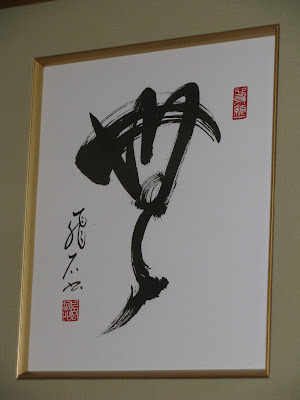On Thursday, April 7, the Sennin Foundation Center for Japanese Cultural Arts will offer FREE introductory classes in Japanese yoga and martial arts. The classes will start at 7 PM at 1053 San Pablo Ave., Albany, California. The teacher will be Kevin Heard Sensei, who has nearly 30 years of training in both disciplines. He will focus on principles of mind and body unification common to both arts. To attend these free classes, call 510-526-7518, and leave your name, phone number, and indicate that you would like to participate. Wear loose clothing and arrive 10 minutes before the classes start. Take a look at the text below for more information.
Japanese Yoga & Meditation
Shin-shin-toitsu-do is the form of Japanese yoga and meditation offered at the Sennin Foundation Center. Shin-shin-toitsu-do, "The Way of Mind and Body Unification," was founded in the early 1900s by Nakamura Tempu Sensei.
Nakamura Sensei lived in India, where he studied the art of Raja yoga, the yoga of meditation. After studying medicine at Columbia University, he blended Indian meditation and health improvement with his background in medicine, psychology, Japanese healing arts and meditation, and Japanese martial arts. He taught for many years in Japan, authored best-selling books, and counted among his students a large number of Japan's top executives, politicians, fine artists, athletes, martial artists, and people from every walk of life. But few Westerners have yet been exposed to these extraordinary teachings.
Our Shin-shin-toitsu-do class offers you practical forms of seated and moving meditation, breathing methods for health, stretching exercises, autosuggestion for altering negative habits, stress management, and self-healing techniques that are little-known in the West. Emphasis is also placed on the development of ki (chi in Chinese). Ki amounts to life energy, and its cultivation has a profound effect on mental and physical health. You, like many of our students, may experience greatly enhanced concentration, willpower, calmness, relaxation, and physical fitness.
Make a positive and life-altering decision. Consider adding Shin-shin-toitsu-do to your life, and discover a way of living rooted in health, happiness, and harmony.
Martial Arts
The Sennin Foundation Center presents instruction in Saigo Ryu aiki-jujutsu, a traditional and non-competitive martial art. While many Westerners use "jujutsu," "jujitsu," or "jiu-jitsu" to describe their art of self-defense, most of these methods bear little resemblance to the original Japanese jujutsu, Japan's oldest martial art. Both aikido and judo stem from jujutsu, and our dojo is one of few in the USA to offer authentic Japanese jujutsu.
Our class features a wide variety of powerful throwing, pinning, and grappling techniques stemming from older methods (kobudo) originating in the Aizu-Wakamatsu area of Japan. Saigo Ryu is a sogo bujutsu, an "integrated martial system," and it also features advanced training in the martial arts of the sword, spear, staff, short stick, iron fan, and others. It is unique and unlike many more well-known martial disciplines (like karate-do, kendo, and iaido). While training is vigorous, and the practiced self-defense techniques effective, the emphasis is on subduing an opponent without unneeded injury. Students improve their health while learning martial arts as meditation, which helps them to remain calm under pressure. Some students have likened training in our dojo to "moving Zen."
Our instructors also teach methods for cultivating ki (chi in Chinese). Ki is the life energy that animates human beings, and an understanding of it is useful in both martial arts and daily life.
Instruction in the Shin-shin-toitsu-do system of Japanese yoga and meditation is included at no extra charge. Japanese yoga training makes it easier to master the martial arts, and it helps us to realize our full potential in other activities as well. Give us a call to find out how aiki-jujutsu can help you toward self-protection and self-perfection.




























